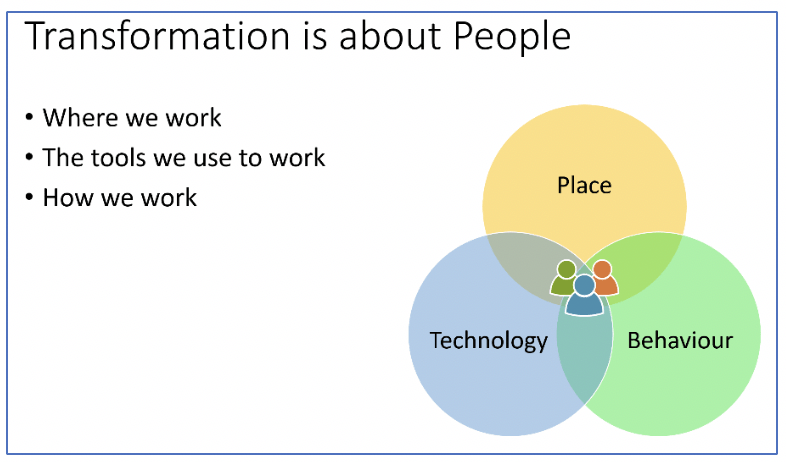I recently recorded a podcast about all things Business Transformation. We talked about the difference between Agile and Waterfall, Scrum and Prince 2, Leadership and Management. It was a whistle-stop tour of my thoughts and reflections on change and transformation. One of the central concepts I offered was that Digital Transformation is first and foremost about people, not just technology. This is, of course, nothing new, but I went on to illustrate my thinking with a simple Venn diagram model, which I use to explain this and I promised I’d write it up as a blog, so here it is.
We talk a lot about businesses becoming more “agile,” applying user-centred design to develop products and services, and then implementing agile service management / Dev Ops to ensure the tech can be responsive, whilst continuing to support the product teams with ongoing development as user needs change. Much of this could be said to be “what” we want to do, but getting to that new state and the way we go about achieving all of this, for me, is where the critical change and transformation happens. This is the “How”.
Conceptually, I group the key things that drive change and transformation into three broad areas creating a Venn diagram which I use to demonstrate the difference between change and transformation.

When we talk about being “digital” we’re really talking about ascribing characteristics, values and behaviours to these groups, meaning there is a journey of “digital maturity” to go on, and I believe that focusing on just one, or maybe two, of these areas is more akin to traditional change; evolutionary and often not really “noticed” until a significant time later when a look back enables a business to see that “we’ve come a long way”. Transformational change is more immediate and can’t be “missed”, it’s characterised by a change in each of these areas simultaneously, and is disruptive and unsettling. Think about those TV makeovers; the transformation is often described as “amazing, stunning, wow” The individuals involved often talk about feeling different, having renewed confidence and about the transformation being “life-changing” and so it is for a transformed business.
This analogy is nice but, of course, a business can’t stop to be taken off and “transformed”, it must hit that digital sweet spot, in the middle of the Venn, whilst continuing to deliver. This means that it’s vital that the vision is one that everyone not only recognises is transformational, but also one that they feel they have a stake in, can align to and see value in.
It was at this point that the podcast talked about how to positively engage people in this change and the difference between management and leadership. This is because, within the “behaviour” group, the necessity is to move from command and control management as the default approach, over to “servant leadership”. This is most definitely a transformational change for many traditional managers/leaders. Transferring “power” to the team, moving decision making as close to the user/customer as possible, reducing governance and control and taking on a more “enabling” role as part of the team rather than being “in charge” of the team, is hard.
But the harsh reality is that a “digital business” can’t be created without the right culture, and that culture is absolutely dependent on servant leadership. Everything else flows from this.
People naturally want to collaborate and work in multi-discipline teams, physically working together when they need to and not being in offices at all when they don’t. Place and technology must enable this; Office space laid out mirroring reporting structures needs to be re-laid to allow activity based working. Tech must enable collaborative, flexible working so that people can be “mobile” and able to work how, when and where they want to. Data and information is, of course, the currency of a user-centred approach which must not only be captured and stored, but also curated and made easily available, so that it can inform and drive decision making and iterative user-centred design. Modern laptops, phones, VC equipment, etc. hosted on modern, secure, responsive IT infrastructure will enable the use of online digital collaborative tools.
“Work is a thing we do, not just a place we go”
This scale of interdependent, transformational change across tech, place and behaviour creates the culture and environment in which an agile, digital approach can thrive and where unnecessary bureaucracy, privilege and inertia is replaced with empowerment, transparency and pace. In the Civil Service this is called “Smarter Working”, and it’s being implemented across the country; they have a great video explaining it.
Reading this far you may be thinking I’m mad or maybe wishing it was like this where you work. If you’re a millennial, working in a digital native business, it may be just the way things are and you can’t imagine ever working in any other way. In the podcast, I talked about the Netflix culture deck and the Spotify developer videos as exemplar digital businesses which have both completely disrupted their industries and which continue to change at pace. The new generations entering the workplace are expecting this environment, culture and way of working, and businesses who do not offer this will struggle to attract and retain the best talent in the future.
So, if change is said to be “messy”, then transformation is “disruptive” and requires total commitment and complete awareness of the scale of change demanded. As this is not evolutionary or developmental change, it requires a “no going back”, “leap of faith” mentality because, as you cross this digital Rubicon, you will also be figuratively burning your boats and there will be no going back. If there is, then it is unlikely that you’re undergoing transformational change.
So where to begin? Well, to achieve this scale of transformational change, the importance of clarity around the vision and purpose can’t be underestimated. But, in this new digital world, a traditional top-down waterfall approach to change won’t work. Digital transformation is value-driven, behaviourally enabled and tech-fuelled, meaning that it’s not the leaderships’ role to figure it all out and “tell” the business how it’s going to be, but rather to create a vision together and enable the business to find their way to create the culture, environment and tools which empower people to collaborate and focus all their talent on creating great products and services which benefit their users.





